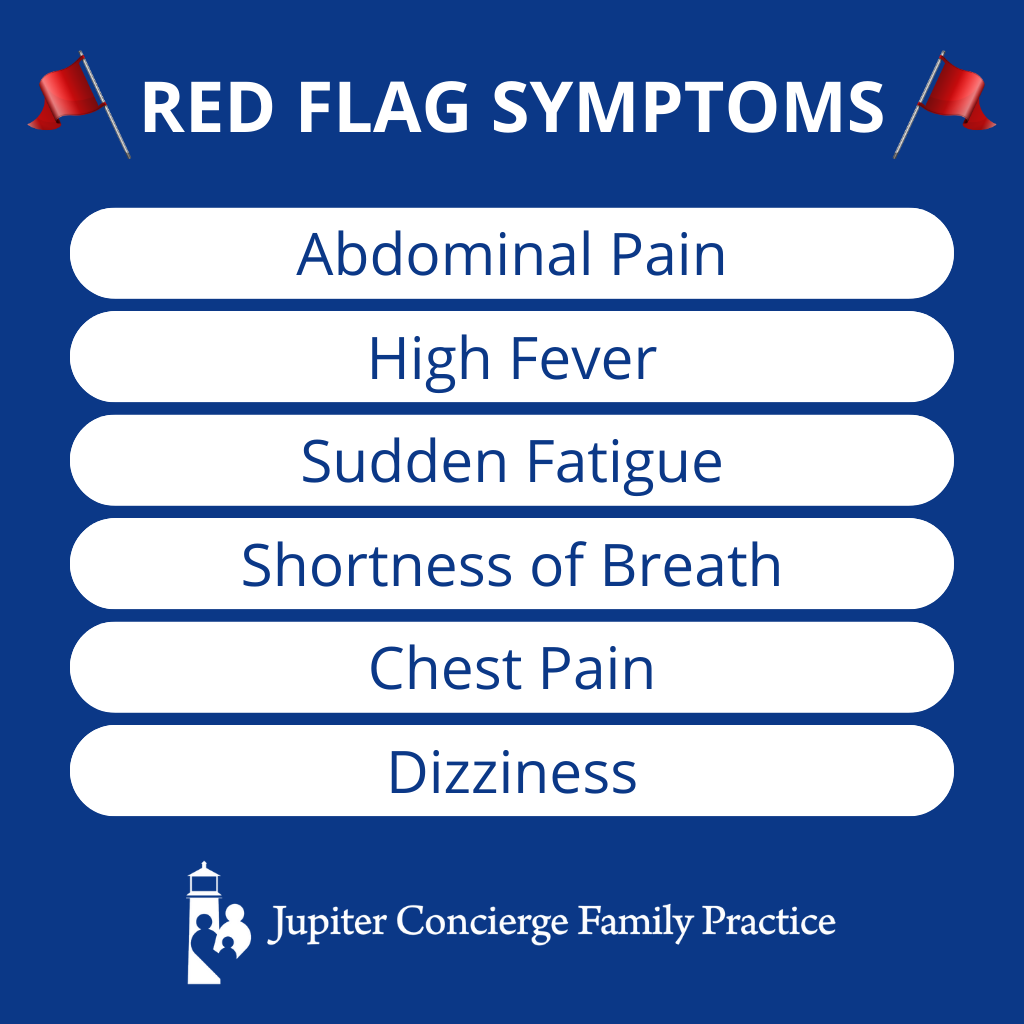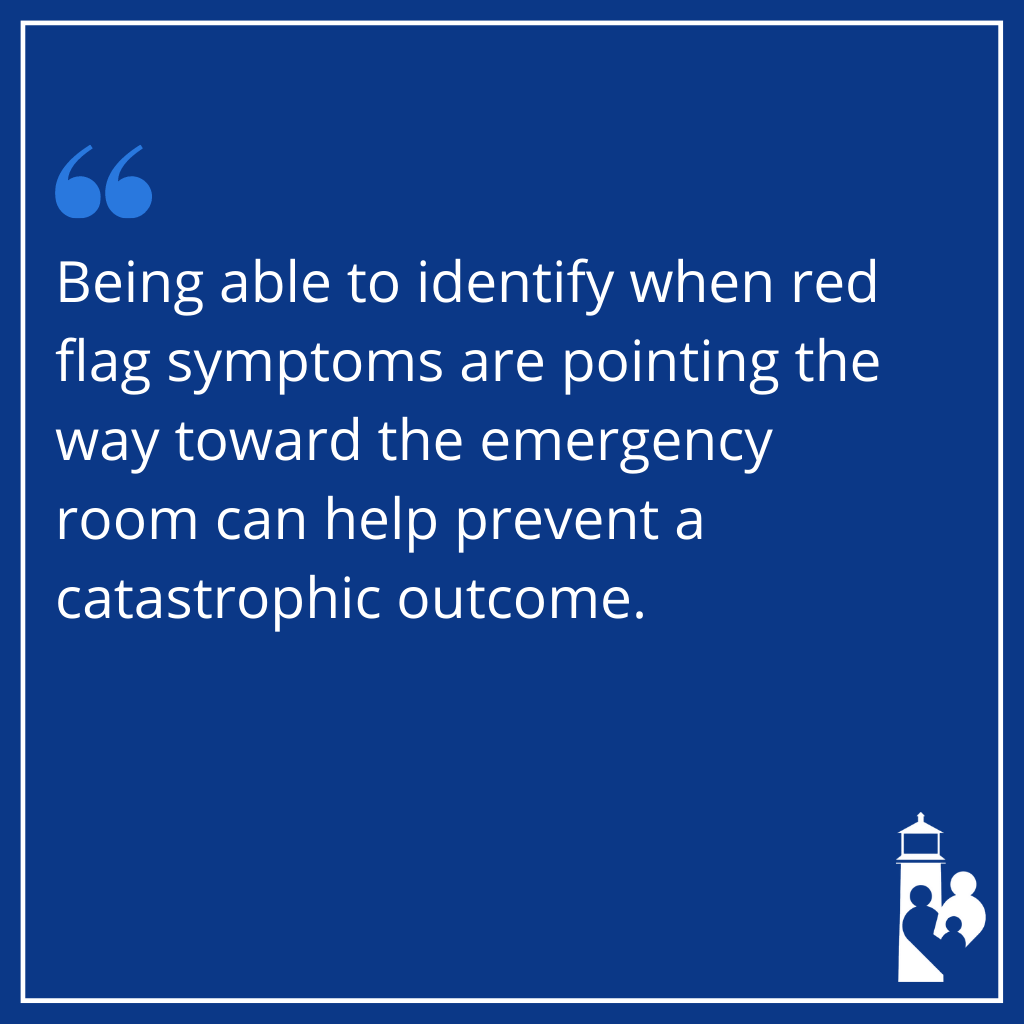
No one wants to take an unnecessary trip to their local emergency room. But how do you differentiate between problems that can wait and problems that require immediate medical attention?
Here we’ll discuss the “red flag symptoms” you shouldn’t ignore. The answer isn’t always going straight to the ER, but these are symptoms that might indicate a problem serious enough to warrant prompt medical assessment.
What Are “Red Flag Symptoms”?
A “red flag symptom” is something abnormal that indicates the possibility of an emergency medical situation. These symptoms are potentially life-threatening, though not necessarily so.
Here are a couple of key factors about red flag symptoms:
- Red flag symptoms persist and worsen. As opposed to being intermittent and fleeting, red flag symptoms hang around.
- Red flag symptoms can either occur on their own or combined with other symptoms.
- Red flag symptoms are often severe.
- Red flag symptoms are usually new and unexplained by recent activities.
If you experience a severe red flag symptom or a combination of multiple red flag symptoms, you should seek medical attention. This could mean notifying your physician and proceeding directly to an emergency room, or calling emergency medical services to come to you.
Let’s take a look at specific red flag symptoms and what they may indicate.
Red Flag Symptom #1 — Abdominal Pain
Abdominal pain consists of intense, sharp, or dull pain in the abdomen. Some serious potential causes of this pain include:
- Appendicitis
- Bleeding Stomach Ulcer
- Diverticulitis
- Cholecystitis (infected gallbladder)
Abdominal pain occurring alongside fever and nausea needs to be checked out promptly by a medical professional.
Appetite can be a helpful indicator of the seriousness of abdominal pain. If your appetite is normal, most of the time the underlying cause is not as serious as if there’s no appetite.
Red Flag Symptom #2 — High Fever
Any temperature two degrees (Fahrenheit) higher than your average is a fever. For some adults, that could be 99.5 degrees; for others, that may be over 100.5.
When your temperature exceeds 3.5 degrees above your average, the situation is serious. This indicates an infection that might need immediate treatment.
Red Flag Symptom #3 — Sudden Fatigue
Fatigue, whether chronic or acute, can be a red flag. But sudden fatigue whose onset can’t be explained is an unequivocal, alarming sign.
If it’s not related to lack of sleep, excess stress, or intense exercise, sudden fatigue can be indicative of heart or lung problems. When associated with chest pain or shortness of breath, sudden fatigue is very concerning and requires immediate medical evaluation.
Red Flag Symptom #4 — Shortness of Breath
Shortness of breath means difficulty breathing, either with activity or at rest. When shortness of breath happens at rest, however, it’s much more alarming and can be urgent. This can be a sign of heart or lung problems or could indicate a serious infection.
Red Flag Symptom #5 — Chest Pain
There are various kinds of chest pain. Of them all, positional chest pain is less concerning. If one particular posture or movement makes your chest hurt, you’re likely experiencing musculoskeletal pain, such as a pulled muscle.
Stifling, pressing pain in the middle of the sternum is a different matter, as is chest pain that radiates down either arm (especially the left). When this pain is associated with nausea or shortness of breath, the alarm bells ring louder. Any or all of these symptoms can indicate heart problems, a heart attack, or blood clots in the lungs, requiring emergency care.
Red Flag Symptom #6 — Dizziness
When dizziness (or lightheadedness) is associated with head or body movement, it isn’t typically urgent. But if it’s associated with fainting episodes, chest pain, and/or shortness of breath, it’s an emergency. This type of dizziness could indicate decreased blood flow to the brain — a stroke — or a heart problem.
Know Your Red Flags
Knowing when red flag symptoms are pointing toward the emergency room can help prevent a catastrophic outcome. Understanding the difference between an urgent red flag and a concerning yet non-urgent symptom can also provide reassurance (and save you the expense of an unnecessary ER visit).
The best way to discern if a problem is urgent is to have a prompt conversation with your physician. If your physician is a concierge physician, so much the better for you. Concierge medicine promotes the kind of prompt dialogue that allows for rapid evaluation of potentially serious problems.

Dr. David Rosenberg
Dr. Rosenberg is a board-certified Family Physician. He received his medical degree from the University of Miami in 1988 and completed his residency in Family Medicine at The Washington Hospital in Washington, Pennsylvania in 1991. After practicing Emergency Medicine at Palm Beach Gardens Medical Center for two years, he started private practice in Jupiter, in 1993. He is an avid baseball fan and Beatles fanatic, since he was 8 years old. He has been married to his wife, Mary, since 1985 and has three grown children.
David completed additional studies at Mercer University, Macon, Georgia and obtained a BS in Chemistry in 1983.
“My interests include tennis, snow skiing, Pilates and self-development.”

Subscribe to our Newsletter!
Receive latest blog posts, health tips, and exclusive offers from Jupiter Concierge Family Practice straight to your inbox.


